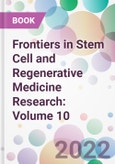Stem cell and regenerative medicine research is an important area of clinical research which promises to change the face of medicine as it will be practiced in the years to come. Challenges in the 21st century to combat diseases such as cancer, Alzheimer’s disease and retinal disorders, among others, may well be addressed employing stem cell therapies and tissue regeneration techniques. Frontiers in Stem Cell and Regenerative Medicine Research brings updates on multidisciplinary topics relevant to stem cell research and their application in regenerative medicine. The series is essential reading for researchers seeking updates in stem cell therapeutics and regenerative medicine.
The chapters cover:
The chapters cover:
- Novel drugs and their stem cell-based targets for osteoporosis: challenges and proceedings
- The role of cancer stem cells in disease progression and therapy resistance
- Stem cells from human exfoliated deciduous teeth in tissue regeneration
- The fate of toxicological studies: from animal models to stem cell-based methods
- Effect of material properties on differentiation of mesenchymal stem cells
Table of Contents
Chapter 1. Drugs and Their Stem Cell-Based Targets For Osteoporosis: Challenges and Proceedings- Osteoporosis and its’ Challenges
- From Osteogenic Lineages To Bone Formation and Resorption
- Development of Osteoblasts from Mesenchymal Stem Cells
- Dependence of Osteoclasts, Osteoblasts, and Osteocytes
- The Pathways of Bone Remodeling
- Disorders of Bone Remodeling: Osteoporosis and Osteopetrosis
- Chemical Aspects of Osteoporosis
- Recent Developments in Osteoporosis Diagnosis
- Acid-Base-Balance Regulating the Bone Cell Function
- Chemical Approaches for Drug Development
- Novel Therapy Approaches For The Treatment of Osteoporosis
- RANKL Inhibitors Decrease the Number of Osteoclasts
- Selective Estrogen Receptor Modulators Reduce Bone Resorption
- Strontium Ranelate - A Promising Intermediate
- Cathepsin K Inhibitors Inhibit the Degradation of Collagen I
- Anti-Sclerostin Antibodies Increase Bone Mineral Density
- Perspectives For Osteoporosis Treatment In The Future
- Concluding Remarks
- List Abbreviations
- Consent For Publication
- Conflict of Interest
- Acknowledgements
- References
- Chapter 2 The Role of Cancer Stem Cells In Disease Progression and Therapy Resistance
- Introduction
- Cancer Stem Cells CSCs In Disease Progression
- Cancer Stem Cells CSCs In Tumor Initiation
- CSCs In Tumor Vasculature
- Role of CSCs In Inflammation-Mediated Cancer Progression
- Interactions of CSCs With Cellular Components In Tumor Microenvironment
- Role of CSCs In Therapy Resistance
- Increased Drug Efflux By ATP-Binding Cassette Transporters In CSCs
- Increased Activation of Detoxification Enzyme In CSCs
- Enhanced DNA Damage Repair and Reactive Oxygen Species (Ros) Scavenging Capacity of CSCs
- Aberrant Activation of Signaling Pathways In CSCs
- CSCs Plasticity and Therapy Resistance
- Quiescent CSC In Therapy Resistance
- Conclusion
- Consent for Publication
- Conflict of Interest
- Acknowledgements
- References
Chapter 3 Stem Cells From Human Exfoliated Deciduous Teeth In Tissue Regeneration
- Introduction
- Insight Into Stem Cells From Human Exfoliated Deciduous Teeth
- Differentiation of Stem Cells From Human Exfoliated Deciduous Teeth and Growth Factors Involved
- Fibroblast Differentiation67 Connective Tissue Growth Factor (CTGF)
- Fibroblast Associated Biomarkers in Fibroblast Differentiation
- Collagen Type 1 (COL1)69 Fibroblast-Specific Protein 1 (FSP1)
- Glycoprotein 130 (gp130)
- Epithelial Differentiation70 Keratinocyte Growth Factor
- Hepatocyte Growth Factor71 Epidermal Growth Factor
- Insulin-Like Growth Factor-2
- Cytokeratin 18 (CK18)
- Filaggrin (FLG)
- Keratin 14 (KRT14).
- Osteoblast/Odontoblast Differentiation
- Fibroblast Growth Factor (FGF-2)
- Bone Morphogenetic Protein
- Osteoblast-Associated Biomarkers in Osteogenic Differentiation
- Alkaline Phosphatase (ALP)
- Osterix (Osx)
- Osteoprotegerin (OPG)
- Signalling Pathway Involved In The Differentiation of Mesenchymal Stem Cells
- Hymal Stem Cells81 Runt-Related Transcription Factor 2 (Runx2) Signaling Pathway In Osteogenic Differentiation
- BMP Signaling Pathway In Osteogenic Differentiation
- WNT Signaling Pathway In Osteogenic Differentiation
- AMPK Signaling Pathway In Osteogenic Differentiation
- Prospect of Stem Cells From Human Exfoliated Deciduous Teeth
- Imal Models To Stem Cell-Based Methods
- Conclusion
- Consent For Publication
- Conflict of Interest
- Acknowledgements
Chapter 4: The Fate Of Toxicological Studies: From Animal Models To Stem Cell-Based Methods
- Introduction
- Drug Toxicity Models
- Types of Stem Cells Used In The Toxicity Analysis
- Stem Cells As Toxicological Models
- Liver Toxicity Models
- Heart Toxicity Models
- Neuron Toxicity Models
- Organoids and Toxicity
- Future Prospects and Conclusion
- Consent For Publication
- Conflict of Interest
- Acknowledgements
- References
Chapter 5: Effect of Material Properties On Differentiation of Mesenchymal Stem Cells
- Introduction
- MSC Response To Stiffness
- MSC Response To Surface Topography
- MSC Response To Surface Chemistry
- MSC Response To Different Nanoparticles
- Hydroxyapatite Nanoparticles (HANPs)
- Silica Nanoparticles (Silica NPs)
- Silver Nanoparticles (Ag NPs)
- Concluding Remarks
- Consent For Publication
- Conflict of Interest
- Subject Index
Author
- Atta-ur-Rahman
- Shazia Anjum









